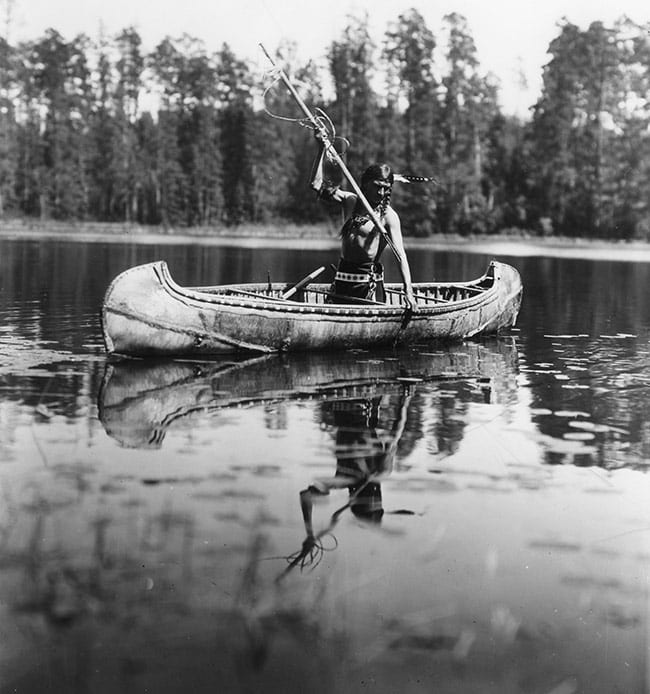
Featured
Flora, Fauna, Fish, and Fowl
Ecological spirituality in Ojibwe cultural practices.
By Tammy Lynn Pertillar
The Anishinaabe Diaspora is an Ojibwe language-speaking community which includes, but is not limited to, the following cultural groups: Ojibwe/Ojibwa (can be spelled with the letter “e” or the letter “a”); Chippewa, Ottawa, Couchiching First Nations, Oji-Cree (Ojibwe and Cree cultures together); Potawatomi, and Saulteaux.
The majority of Ojibwe-speaking communities are located in the following states and provinces in North America: Michigan, Minnesota, North Dakota, and Wisconsin in the United States; Ontario and Manitoba in Canada; and the Great Lakes Region, which spans the US and Canada.
Since “Ojibwe” is the term that is most commonly recognized, it is the one that is used throughout this essay. This essay centers on ecological spirituality in Ojibwe cultural practices, focusing on Flora, Fauna, Fish and Fowl.
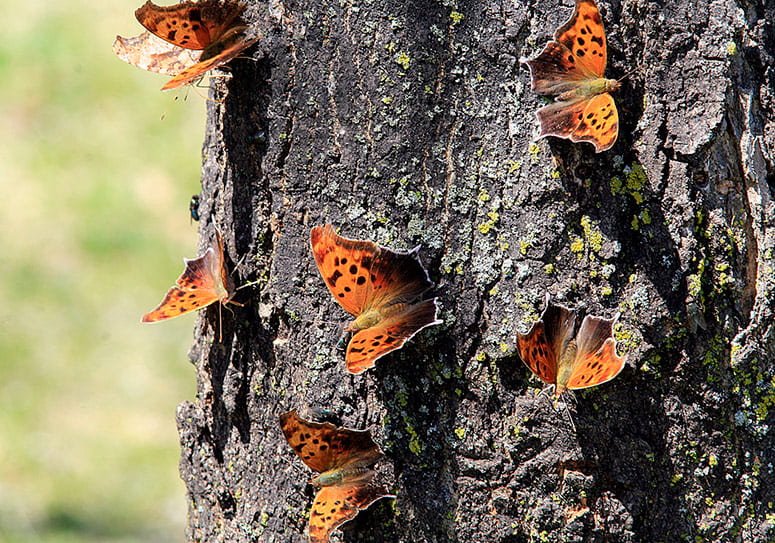
Admiral butterflies drinking sap from a maple tree, Point Pelee Park, Ontario, Canada, 2012. Alan Wormington
Flora
Maple trees are sacred in Ojibwe culture. Maple syrup traditionally has been important for the Ojibwe in terms of survival during long winters, so they consider it a sacred food.1 It does not have to be planted, nor does it need to be harvested from the ground; rather, it already exists inside the tree itself as provided by Creator.
Iskigamiige-giizis: Maple Syruping Moon
Iskigamiige-giizis is the Maple Syruping Moon, which starts roughly in mid-March and runs through mid-April.2 Not unlike Cherokee cultures, within Ojibwe cultures, there are thirteen moons, each of which corresponds to a season, a seasonal activity, or a weather pattern.
When choosing a tree for maple syrup harvesting, not every tree is selected. If the chosen tree is not mature, or if it is mature but is not tapped during the right time of year, it will not give any sap at all, and even if it does, it may be bitter.
Spiritual Concepts:
- Maple Trees come from Creator and are sacred.3
- Maple tree roots connect to other beings which also stem from Creator.4
- In keeping with tradition, women are the original sap gatherers; men and children are sap gatherers today as well.5
- Trees are carefully selected for maturity in due season (prayers).
- Tap once to preserve the tree in relation to its family (prevent scarring). Sap is the maple tree’s lifeblood.
- If chosen well, the same tree can give sap each year thereafter indefinitely.
- Stewardship: Preserve the tree so that other beings can enjoy the sap as well (butterflies, porcupines, hummingbirds, woodpeckers, squirrels, and bats).
- Ecological Spirituality: The cultural teaching is that hard work is vital, because where maple syrup is concerned, there is a 40:1 ratio. It takes forty gallons of maple sap to produce one gallon of maple syrup.6
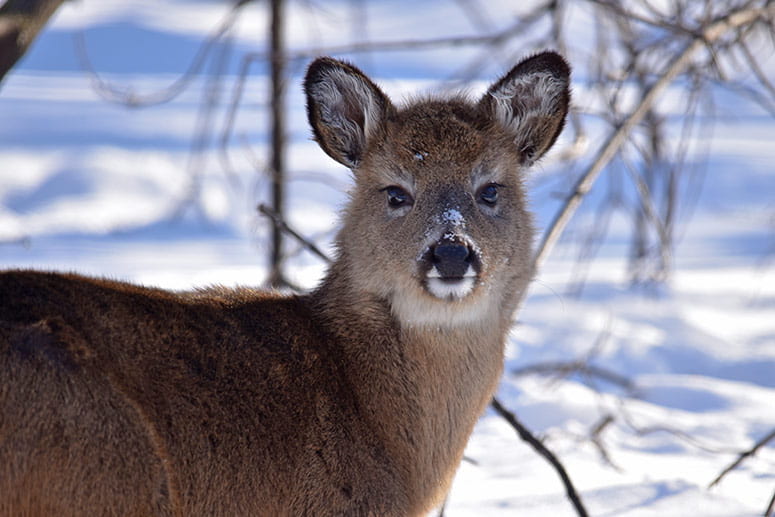
Young white-tailed deer, March 6, 2019. Courtney Celley/U.S. Fish and Wildlife Service-Midwest (USFWS)
Fauna
Deer, including white-tailed deer, are sacred in Ojibwe culture.
In keeping with tradition, mostly men are hunters, with some women serving as hunters, too—and the tradition is passed on to younger generations.
Oftentimes, within Indigenous cultures, we see the transmission of culture in keeping with gender. When customs begin to fade, they start bringing in the other gender in order to continue traditional practices in deer hunting, which has been the case historically.7
The deer are carefully chosen in due season with prayers. When choosing deer, Ojibwe hunters ask for forgiveness.
Spiritual Concepts:
- Deer come from Creator and are sacred.
- Deer are herbivores and selective consumers of vegetation that connects to other beings.
- In keeping with tradition, mostly men are hunters, but some women, too. Tradition is passed on to younger generations.
- Deer are carefully chosen in due season (prayers).
- Deer have families: take only what is necessary (subsistence).
- Sport hunting and deer farming are not traditionally part of the value system.
- Stewardship: Preserve deer herds so that other beings can continue their cycles of life. (Deer food: Wild alfalfa, twigs, berries, leaves and grasses. Deer predators: coyotes and coywolves, as well as wolves and black bears.)8
- Ecological Spirituality: The cultural teaching is that Creation is ongoing. Deer represent love, peace, and ambassadorship.
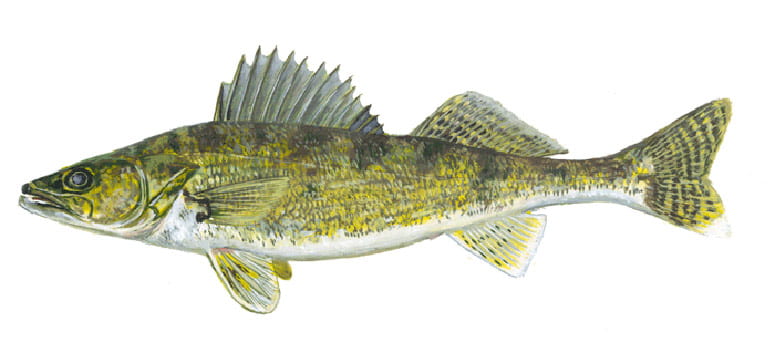
Walleye. Virgil Beck/Wisconsin Department of Natural Resources
Fish
One of the more popular fish that is harvested by Ojibwe fishermen and fisherwomen is the Walleye.
In keeping with Native American and First Nations cultural thought, for the Ojibwe, in the nine months prior to birth, the water that is there is considered to be connected to water around the world.
Fish come from Creator. Fish are sacred because they exist only in water, which is spiritually connected to diverse walks of life at many stages.
With respect to fishing customs, in autumn and winter, for example, the Lac du Flambeau Chippewa still harvest fish at nighttime, just as their ancestors did. These days, in order to see in the dark, they use battery-powered headlamps instead of affixing torches to the ends of their birchbark canoes like their forebears used to do.
In terms of ecological spirituality, replenishment of resources is a central factor that drives cultural response in alignment with seasonal activities. This would include being focused on conserving fish populations through fish hatcheries.9
Spiritual Concepts:
- Fish come from Creator and are sacred.
- Fish exist only in water, which is spiritually connected to diverse forms of life at many stages.
- In keeping with tradition, which is passed on to each generation, women go netfishing in the daytime (spring and summer). Men icefish in daylight and spearfish at nighttime (fall and winter: Lac Du Flambeau-Chippewa).
- Fish are carefully chosen in due season (prayers).
- Fish have families; take only what is necessary (subsistence fishing) and replenish (commercial fishing).
- Sport fishing is not traditionally part of the value system.
- Stewardship: Preserve fish schools so that other beings can continue their lifecycles (Walleye Food: yellow perch, aquatic insects. Walleye Predators: white bass, catfish).
- Ecological Spirituality: The cultural teaching centers on the concept of replenishment in support of biodiversity.
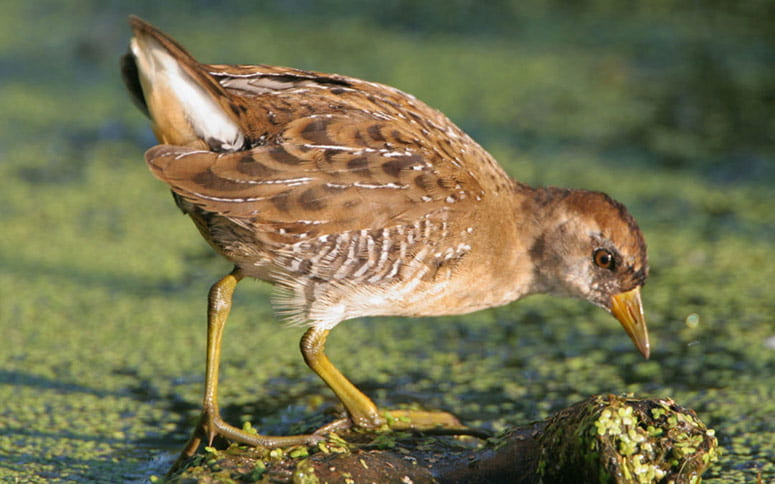
Sora Rail eating wild rice, October 28, 2016. Scott Franke
Fowl
In Ojibwe culture, fowl are considered sacred. In keeping with Native American and First Nations beliefs, birds are able to fly in the air towards Creator. The breath of life is understood as air, which comes through Creator.
Waterfowl exist in wetlands, spiritual spaces that connect amphibious life as well as marshland waterfowl that can navigate land, air, and water.
In keeping with tradition, mostly men hunt waterfowl; women may accompany men and continue traditional practices in preparing fowl as has been the case historically.10
In terms of cultural beliefs, the concept of humility, which one finds across Native American and First Nations cultures, is the idea that no one person is going to know everything. Thus, something that exists in Creation does not have to also exist in relation to a person. In other words, the Sora Rail does not have to have a purpose for people in order to have a purpose for being here on Earth, because Creator made it. And the fact that the Creator made it is enough of a reason.
Spiritual Concepts:
- Fowl come from Creator and are sacred. Birds that are able to fly are thought to fly towards Creator. The breath of life is understood as air, which comes through Creator.
- Waterfowl exist in wetlands, which are spiritual spaces that connect amphibious lifeforms.
- Fowl have families; take only what is necessary (subsistence).
- Sport hunting is not traditionally part of the value system. Amongst the Ojibwe, the Sora Rail is not hunted. It is also not kept as a domesticated pet.
- Stewardship: Hunt fowl (ducks and geese) as per tradition (subsistence).11
- Preserve fowl populations so that other beings can continue their lifecycles (Sora Rail food: beetles, dragonflies, wetland seeds, wild rice. Sora Rail predators: minks, coyotes, crows).
- Ecological Spirituality: Creation is ongoing. Avoid disturbing nesting areas. Practice humility.

Wild Rice. October 28, 2016. Great Lakes Indian Fish and Wildlife Commission
Wild Rice
Minominikee-Giizis: Wild Rice Making Moon
White Earth Anishinaabe, Harvard University graduate, and land conservationist Winona LaDuke acknowledges the central role of Wild Rice as a sacred foodsource.12 Leading scholar of Ojibwe culture and language, Dr. Anton Treuer, states the following:
Tribal elders tell legends about a time more than a thousand years ago when their prophets told the people to travel west from their ancestral homelands on the Atlantic Coast to “the land where food grows on water.” That land was the wild rice country of Minnesota, Wisconsin, Michigan, Ontario, and Manitoba.13
During Minominikee-Giizis, wild rice beds serve as seasonal habitats and nesting cover for migratory waterfowl. In autumn, the Sora Rail gets the majority of its nutrients from Wild Rice.14
Wild Rice is provided by Creator. It is not cultivated by humans. No one has to plant it, and it comes back every year if treated properly.
Wetland birds experience life in air as well as in water and on land, which represents a spiritual concept of ecological balance. Women connect to water and control the harvest.
Families go ricing only in certain sections of the wild rice area. In keeping with tradition, wild rice fronds are not cut; rather, two sticks are used for harvesting. Families travel in small, narrow, canoes in order to preserve plant roots.15
One stick is used to select the frond that is the longest and most mature. It is bent slightly over, and then the other stick is used to knock the rice into the canoe.
The Ojibwe select mature plants, and the remaining seedlings and vegetatives are left to mature for future harvests.
Families must respect each other’s boundaries when they are ricing, and those boundaries are already set by the ground covers inhabited by migrating birds.
Spiritual Concepts:
- Wild Rice beds serve as seasonal habitats and nesting cover for migratory waterfowl.
- Wetland birds experience life in air, water and land (spiritual concept of ecological balance).
- Women connect to water and control the wild rice harvest. Families go ricing in certain sections.
- In keeping with tradition, wild rice fronds are not cut; rather, two sticks are used for gathering.
- Travel in small, narrow canoes to preserve plant roots.
- Select mature plants. Remaining seedlings and vegetatives are left to mature for future harvests.
- Ecological spirituality: Creation is ongoing. Wild Rice gathering instills values such as collective work and respecting natural boundaries.
All beings come from Creator
In Ojibwe cultural thought, all beings come from Creator. Such cultural thinking connects to the concept of animism, a common belief across Native American and First Nations cultures which holds that all beings coming from Creator have souls.
Notes:
- Anton Treuer, “Ojibwe Lifeways,” Young Naturalists, Minnesota Conservation Volunteer, September-October 2012, 41.
- Winona LaDuke, “Seeds of Our Ancestors, Seeds of Life,” TED Talk, June 2011.
- Larry “Amik” Smallwood, “Ojibwe Stories: Gaganoonididaa: Maple Syrup,” KUMD 101.3-FM, Duluth, Minnesota, April 20, 2015, in Erik Martin Redix, “Maple Sugaring and the Ojibwe,” MNOPEDIA, Minnesota Historical Society, first published September 28, 2018.
- LaDuke, “Seeds of Our Ancestors, Seeds of Life.”
- Smallwood, “Ojibwe Stories: Gaganoonididaa: Maple Syrup,” in Redix, “Maple Sugaring and the Ojibwe.”
- Treuer, “Ojibwe Lifeways,” 41.
- Priscilla K. Buffalohead, “Farmers, Warriors, Traders: A Fresh Look at Ojibway Women,” Minnesota History, Summer 1983, 238.
- “White-tailed Deer Studies in Northeastern Minnesota,” International Wolf Center.
- “Six Private and Three Tribal Hatcheries Get Grants to Increase Walleye Production Capacity,” Wisconsin Department of Natural Resources, April 1, 2014.
- Buffalohead, “Farmers, Warriors, Traders: A Fresh Look at Ojibway Women,” 238.
- Treuer, “Ojibwe Lifeways,” 42.
- LaDuke, “Seeds of Our Ancestors, Seeds of Life.”
- Treuer, “Ojibwe Lifeways,” 44.
- “Wild rice: food for migrating waterfowl,” Wisconsin Wetlands Association, October 28, 2016.
- Alicia Chapman, “Wild Rice: Minnesota’s Ancient Grain,” Lake Country Journal.
Tammy Lynn Pertillar has completed graduate research in the History of Medicine at Johns Hopkins University. She has teamed with practitioners for public health projects and publications with the World Bank and World Health Organization. The daughter of Cherokee speakers through the maternal line, her research centers on comparative Native American and First Nations cultures.
Please follow our Commentary Guidelines when engaging in discussion on this site.


With All Due Respect
To Whom It May Concern
Thank you for sharing these cultural practices and sacred traditions. Always listening and always trying learn.
Many Thanks
Charles Saulnier II
(Pronounced Sun-Yeah 😉